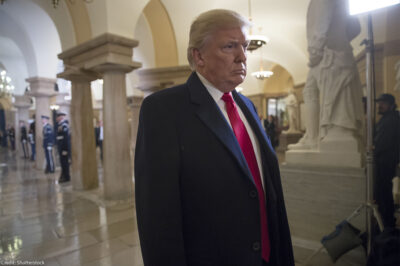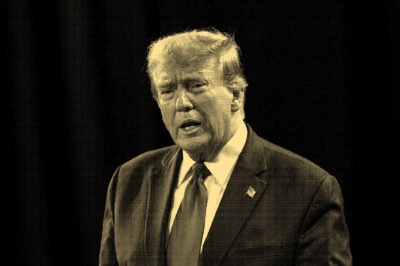Donald Trump: A One-Man Constitutional Crisis


This piece was originally published on Medium.com on July 13, 2016.
INTRODUCTION
Last June, Donald Trump rode down the escalator of his Trump Tower to the tune of Neil Young’s “Rockin’ in the Free World” to deliver a message: He, Donald J. Trump, was announcing his candidacy to become the Republican Party’s 2016 nominee for president of the United States of America. During his speech, Trump basked in the crowd — which included paid actors cheering his name and wearing t-shirts with his campaign slogan, “Make America Great Again” — before uttering some of the statements that would make him such a polarizing force in American politics.
“When Mexico sends its people, they’re not sending their best,” he said. “They’re sending people that have lots of problems, and they’re bringing those problems with us. They’re bringing drugs. They’re bringing crime. They’re rapists.” Towards the end of his speech, Trump double downed on his Mexican fear-mongering, promising to “build a great, great wall on our southern border” at Mexico’s expense if he were elected president.
One year later, Donald Trump has all but clinched the Republican nomination for the president of the United States. Throughout his presidential campaign, Trump has sparked controversy after controversy with his stated positions on immigration, American Muslims, torture, and the core First Amendment protections that define America. Taken together, his statements and policy proposals would blatantly violate the inalienable rights guaranteed by the Constitution, federal and international law, and the basic norms of a free and decent society.
In the event of a Trump presidency, we have undertaken a constitutional analysis of his most controversial policy proposals. These include his pledges to deport over 11 million undocumented immigrants, to ban Muslims from entering the United States, to surveil American Muslims and their houses of worship, to torture again, and to revise libel laws. We have found them all wanting, to say the least. According to our analysis, Trump’s proposals taken together would violate the First, Fourth, Fifth, and Eighth Amendments to the Constitution.
If Donald Trump is elected president and tries to implement any of these proposed policies, he and the U.S. government will spark legal and constitutional challenges that will require all hands on deck at the ACLU. The ACLU and its more than 300 attorneys in all 50 states, Puerto Rico, and Washington, D.C., stand ready to challenge and impede implementation of his proposals, should he see them through. (Donald Trump, after all, changes his positions all of the time.)
Have no doubt about it: Donald Trump’s policies, if implemented, would trigger a constitutional crisis. But you can also be certain that the ACLU will fight in the courts, in Congress, and in the public square to preserve the rights guaranteed to all people by the Constitution and our Bill of Rights.
Donald Trump may believe the president is above the law, but he is mistaken. As always, we are standing guard to ensure that the rule of law always remains stronger than the rule of one man.
TRUMP ON IMMIGRATION

Donald Trump has repeatedly pledged to deport within two years every undocumented person in the United States, a population of over 11 million people, according to the Pew Research Center. Trump told 60 Minutes’ Scott Pelley that this massive round-up of undocumented immigrants would be carried out “in a very humane way, a very nice way.”
This, however, is impossible. Trump’s mass deportation scheme would mean arresting more than 15,000 people a day on immigration charges, seven days a week, 365 days a year.
From a civil liberties standpoint, there is no conceivable mechanism to accomplish the roundup that Trump has promised while respecting basic constitutional rights. The reason is simple: Undocumented immigrants are not readily identifiable as such, unless they come to the attention of the authorities.
Thus, the vast majority of noncitizens eventually removed are identified either through contact with the criminal justice system or are found and arrested in the process of attempting to enter the United States. To carry out his mass deportation scheme, Trump would have to cast his dragnet far deeper into American communities. Even if massive taxpayer dollars could be diverted to do so as a practical matter, the effort will erode the civil liberties of all.
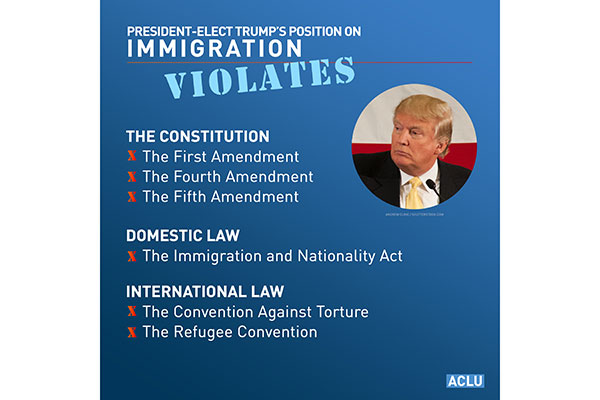
Trump’s plan would undoubtedly violate the Fourth Amendment’s prohibition “against unreasonable searches and seizures.” As the ACLU has argued in its opposition to state immigration enforcement laws like Arizona’s “show me your papers” law, interior immigration enforcement relies on tactics like suspicionless interrogations and arrests, unjustified traffic stops, warrantless searches of workplaces and homes, and door-to-door raids of immigrant neighborhoods. And since immigration officers inevitably resort to racial and ethnic profiling to carry out their orders, they violate the Fifth and 14th Amendment guarantees of equal protection under the law.
But the constitutional problems with his plan don’t stop there. The Constitution requires that the government provide due process to individuals in deportation proceedings. Simply put: An immigrant facing deportation gets to go before an immigration judge and make her case against removal, and the Constitution requires federal court review of the legality of a removal order.
Congress has also created a variety of humanitarian grounds for relief from deportation, such as to provide trafficking victims and survivors of domestic abuse protection from harm. Our immigration courts are also presently weighed down by staggering funding problems and backlogs — immigrants facing removal already have to wait an average of 635 days for an immigration hearing. If Trump were to try and make good on his promise to speedily deport more than 11 million people, he could only do so by trampling on the Fifth Amendment’s due process protections.
To compound the problems with Trump’s undocumented immigrant removal plan even more, the candidate has pledged to detain all undocumented immigrants crossing the border “until they are sent home.” This “no-catch-and-release” policy would once again violate undocumented immigrants’ right not to be deprived of their liberty without due process of law under the Fifth Amendment.
These due process principles, according to longstanding Supreme Court precedents, apply “to all persons within the United States, including aliens, whether their presence is lawful, unlawful, temporary, or permanent.” Immigration detention can only be applied constitutionally when it is necessary to carry out deportation — for example, to deal with an individual who presents a flight risk. And the only way to assess these risks is at a bond hearing presided over by an immigration judge.
Undocumented immigrants who have done nothing wrong, however, need not worry because President Trump will create an “expedited process” to allow “the good ones” to reenter the country. But this, like the rest of Trump’s deportation proposal, is fantasy.
The wait for a U.S. visa can already stretch into the decades. And regardless, under current law, the vast majority of undocumented immigrants deported by a Trump administration would be subject to a 10-year bar from re-entering the country. Thus Trump’s proposal that “the good ones” may return is an empty promise, as preposterous and legally unsound as the rest of his mass deportation scheme.
Last November, Trump provided an example of what his deportation plan would look like. During a Republican presidential debate in Milwaukee, Trump said that the model for his plan was an aggressive immigration enforcement campaign undertaken by the Eisenhower administration in 1954 and 1955.
“‘I like Ike, right? The expression. ‘I like Ike,’” Trump told the crowd. “Moved a 1.5 million illegal immigrants out of this country, moved them just beyond the border. They came back. Moved them again beyond the border, they came back. Didn’t like it. Moved them way south. They never came back.”
While experts differ over how many people were in fact deported during Eisenhower’s campaign, the conditions they experienced during their deportation by land, sea, and air were often cruel and dehumanizing, according to historian Mae Ngai. She writes in her book, “Impossible Subjects,” that in one instance, 88 undocumented immigrants died of heat stroke after they were rounded up in 112-degree heat and dumped in the Mexican desert. In another episode, a Mexican labor leader described undocumented immigrants being brought into Mexico “like cows” on trucks and then dropped off 15 miles away from the border in the desert. One congressional investigation compared a deportation vessel packed with undocumented immigrants to an “eighteenth century slave ship” and a “penal hell ship.”
This spectacular act of government cruelty that Trump wants to use as a model was known as “Operation Wetback” — an ethnic slur for undocumented Mexicans living in the United States.
There is no way around it: Donald Trump’s deportation policy would be an unconstitutional apparatus of human misery, which would effectively turn large areas around the Southwest border into a police state.
Donald Trump’s immigration policy, however, isn’t just about deportation, but exclusion, too.
In the aftermath of the San Bernardino shooting in December 2015, Trump called for “a total and complete shutdown of Muslims entering the United States until our country’s representatives can figure out what is going on.” He reiterated this call after the latest mass shooting at an LGBT nightclub in Orlando.
Trump then went even further, arguing that the immigration system itself was to blame because the shooter’s parents emigrated from Afghanistan to the United States. “The bottom line,” he said in a speech last month, “is that the only reason the killer was in America in the first place was because we allowed his family to come here.”
Trump’s message couldn’t be any clearer: Immigrants and their American-born descendants, particularly Muslims, aren’t really Americans. Worse, they’re a potential fifth column subverting the nation from within. In a nation of immigrants, this sentiment is as un-American as it gets.
To carry out his proposed Muslim ban, Trump has pointed toward executive authority under immigration law “to suspend entry into the country of any class of persons that the President deems detrimental to the interests or security of the United States.” But his temporary ban of all Muslims entering the country would violate the Constitution for many reasons. By singling out Muslims, his entry ban would violate the establishment clause of the First Amendment by explicitly disapproving of one religion and implicitly favoring other faiths.
In attempting to defend Trump’s religious ban, some commenters have noted that there is a long history of race discrimination in U.S. immigration policy. But there has never been an immigration ban on the basis of religion. In part, this likely reflects the priority of religious neutrality since the founding of the nation.
Were Trump to apply his ban to Muslim U.S. citizens or lawful permanent residents who left and tried to reenter the country, he would be proposing a blatant violation of the Constitution in two more areas. First the government is forbidden under the Fifth and 14th Amendments from revoking an American’s citizenship and banishing him based on the person’s creed.
Second, any religion-based bar on lawful permanent residents trying to reenter the country would violate the due process clause. As the Supreme Court ruled in 1953, a lawful permanent resident’s “status as a person within the meaning and protection of the Fifth Amendment cannot be capriciously taken from him.”
Trump’s Muslim ban could also run afoul of international law, such as the Refugee Convention and the Convention Against Torture, by refusing asylum to people fleeing persecution and violence. And aside from the constitutional and international law problems, there’s another solid reason for Trump to reconsider his discriminatory proposal. “It would make the United States a virtual pariah among nations,” constitutional scholar Jonathan Turley told The Washington Post.
TRUMP ON MUSLIM SURVEILLANCE
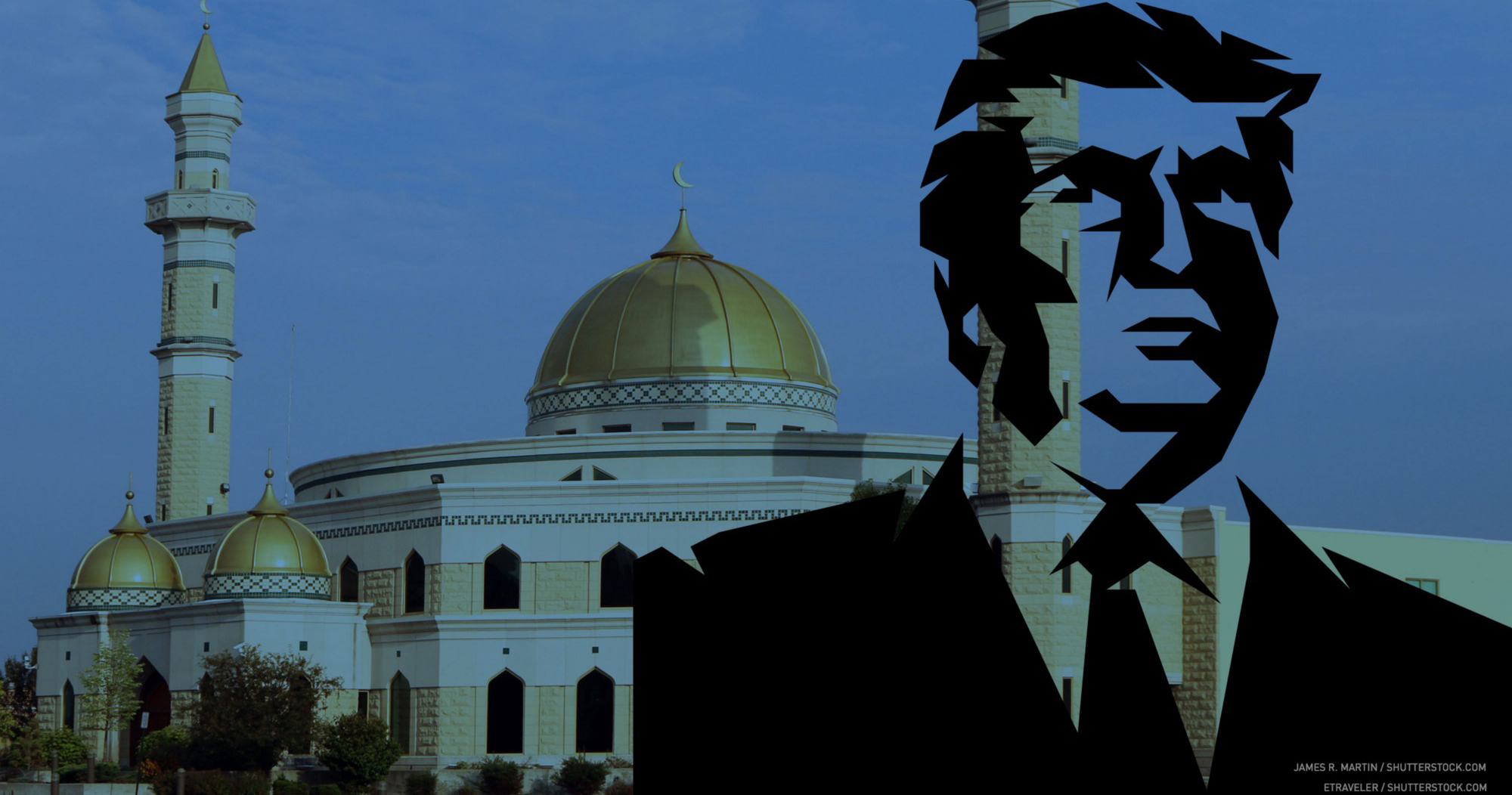
Donald Trump’s Muslim problem isn’t restricted to people traveling to the United States. It includes about 3.3 million American Muslims. In the aftermath of high-profile attacks in Europe and the United States, Trump has put forth counterterrorism proposals that wrongly stigmatize American Muslim communities as suspect and are grounded in discrimination.
Trump told NBC News last November that “we should have a lot of systems” to track American Muslims. They would be obligated, for example, to register with a special database for Muslims in the country. When asked by Yahoo News whether he would support requiring Muslims to carry a special ID card, he didn’t rule it out, noting “we’re going to have to have to do certain things that were frankly unthinkable a year ago.”
To that end, Trump would monitor mosques and American Muslim communities across the country. “We’re going to have to look at mosques,” he told the reporter. “We’re going to have to look very, very carefully.” In response to the Brussels attack in March, Trump agreed “100 percent” with Sen. Ted Cruz’s statement that U.S. law enforcement must have the power “to patrol and secure Muslim neighborhoods before they become radicalized.”
If a President Trump acted unilaterally — or somehow convinced Congress — to implement a surveillance program explicitly targeting Muslims because of their faith, he would face an impossible task of defending such a policy as constitutional in court. This is because the discriminatory profiling and surveillance of American Muslims would violate the First and Fifth Amendments to the Constitution.
Thanks to the right to equal protection under the law guaranteed by the Fifth Amendment, courts are rightly very suspicious of any law or government policy that singles out groups of people united by a core characteristic, like race or religion. Therefore any law passed or policy pursued by a Trump administration that specifically subjects Muslims to heightened suspicion, surveillance, or special registration because of their religion would be met by the courts with a heightened degree of scrutiny.
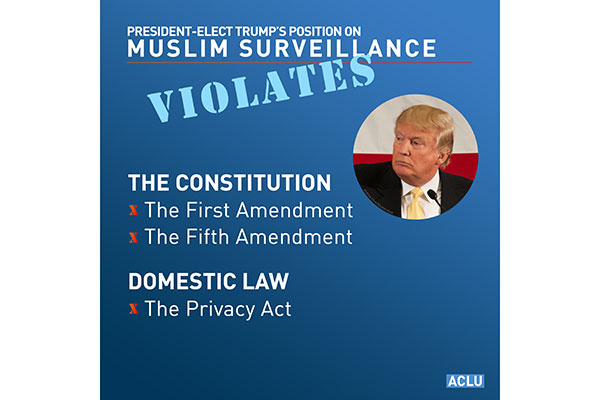
Judges do so with good reason. It’s worth remembering that the New York City Police Department program didn’t just alienate people from law enforcement — it also made for bad policing. In fact, NYPD Police Commissioner Bill Bratton has admitted that no actionable intelligence came out of a core component of the Muslim surveillance program. In its settlement of an ACLU lawsuit against the program, the city of New York explicitly recognized that law enforcement can do its job without resorting to discriminatory practices.
Targeting Muslims for law enforcement scrutiny based on their faith would also make a mockery of the First Amendment, which bars government action that singles out particular faiths for disfavored treatment or restricts or interferes with religious practices. The NYPD case makes the reasons for this foundational protection abundantly clear.
The police department’s practice of infiltrating houses of worship with informants and undercover cops resulted in diminished attendance at mosques, pervasive mistrust among congregants, and community-wide self-censorship. Some community members went so far as to change their dress and trim the length of their beards out of fear of unwarranted surveillance. Trump’s proposals are precisely the types of assaults on religious communities that the First Amendment was designed to prevent.
The Supreme Court has warned that “a law targeting religious beliefs as such is never permissible.” This apparently doesn’t give Trump pause when he calls for unmerited law enforcement attention devoted to American Muslim communities across the country.
Trump’s proposed Muslim database would also violate the Fifth Amendment’s due process clause if it were used by the government to restrict the ability of an American Muslim to fly or if it triggered more unjustified attention at border crossings. No one in America should be treated like a criminal and deprived of their liberty and dignity when they have done nothing wrong.
Beyond the constitutional problems with a Muslim database, the policy would almost certainly violate federal law. The Privacy Act of 1974 bars the federal government from maintaining records “describing how any individual exercises rights guaranteed by the First Amendment.” That, of course, includes records on expressions of faith.
When considered fully, the effect of Trump’s anti-Muslim policies would be to reproduce the same stigma and discrimination that Muslim New Yorkers suffered, only this time it would be national in scope. Entire Muslim communities would be gripped by fear of their own government.
By continuing to push these policies, Trump demonstrates that he will try and turn religious bigotry into government policy in flagrant violation of one of this country’s bedrock principles. As the Third Circuit Court of Appeals has recognized, “Religious discrimination, ‘by [its] very nature,’ has long been thought ‘odious to a free people whose institutions are founded upon a doctrine of equality.’” The belief in religious freedom has made America a beacon to the world for more than two centuries.
Donald Trump, it seems, is not so impressed.
TRUMP ON TORTURE

Donald Trump wants to make America torture again.
“I love it. I love it, I think it’s great,” Donald Trump said earlier this year, describing his enthusiasm for waterboarding, otherwise known as simulated drowning.
In addition to declaring his affection for the barbaric practice, which he has referred to as “minimal torture,” Donald Trump has vowed to “absolutely authorize something beyond waterboarding.” He has also said he would authorize torture in a manner that would comply with controlling “laws and treaties.” And if that doesn’t work — and it couldn’t — a President Trump would seek to change the laws to permit torture.
In other words, Trump wants to take the United States back to the darkest days of the Bush administration, when our country flouted more than three centuries of Anglo-American jurisprudence, which rejected the use of torture and cruelty as a means of extracting information or inflicting punishment. This rejection is firmly enshrined in the Constitution, domestic law, and international law.
That torturing people again is even on the agenda is nothing short of an abomination. It’s important to remember the brutality of the Bush administration’s euphemistically named “enhanced interrogation techniques” that Trump wants to resurrect. These were a set of techniques designed and implemented with the goal of psychologically destroying detainees in CIA custody.
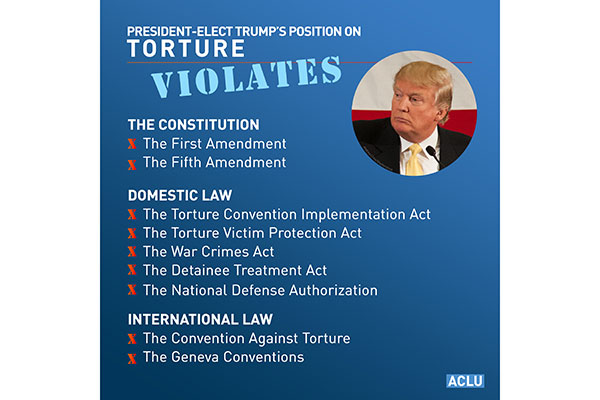
Interrogators in CIA prisons kept detainees awake and standing in painful positions for days at a time, doused them with ice water, slammed them into walls, waterboarded them, and more. The techniques were used together in rapid succession, interspersed with aggressive interrogation sessions, in the name of an invented and unscientific theory positing that reducing detainees to a state of utter passivity could result in useful intelligence — which it didn’t.
Imagining Trump attempting to reinstate torture as policy is a nightmarish proposition. Thankfully, a web of domestic and international laws — compounded by the lessons of our recent, and catastrophic, experiment with state torture — ensures he would fail.
Torture is a clear violation of our Constitution. Courts have recognized that the Fifth Amendment’s due process clause bars treatment that “shocks the conscience,” including interrogation by torture. And the infliction of torture as punishment violates the Eighth Amendment’s prohibition on “cruel and unusual punishment” and has been explicitly prohibited since the 19th century. The torturer, a U.S. appeals court recognized in 1980, is “like the pirate and slave trader before him . . . an enemy of all mankind.”
Congress has also registered its collective disgust at torture and demonstrated the need for accountability. The international legal prohibition of the practice was enshrined in domestic law when the United States signed and ratified the Convention Against Torture decades ago. When President Ronald Reagan sent the convention to the Senate, he wrote that the Senate’s consent to ratify would “demonstrate unequivocally our desire to bring an end to the abhorrent practice of torture.” Federal statutes barring or criminalizing torture and cruel treatment include the Torture Convention Implementation Act, the Torture Victim Protection Act, the War Crimes Act, the Detainee Treatment Act of 2005, and the 2016 National Defense Authorization Act.
International law is explicit that the absolute ban on torture also applies in wartime. Common Article 3 of the Geneva Conventions bars torture and also requires that detainees “shall in all circumstances be treated humanely” and prohibits “outrages upon personal dignity, in particular humiliating and degrading treatment.”
The Convention Against Torture likewise provides that “[n]o exceptional circumstances whatsoever, whether a state of war or a threat of war, internal political instability or any other public emergency, may be invoked as a justification of torture.” The Supreme Court’s recognition in 2006 that these protections apply to detainees held by the United States played a critical role in reining in abuses at Guantánamo and at CIA and military prisons abroad.
To evade these many prohibitions, the Bush administration performed a complex set of now-notorious legal gymnastics to redefine torture and sidestep the ban. In a series of secret memos that have since been widely denounced, the U.S. government employed deceptive interpretations of the law to unmoor the country from its domestic and international commitments.
It would take years for the American public to learn the contours of what the CIA and military did in secret. Once they did, the program began to contract — as it happens when illegality emerges from the darkness in a democracy. Bipartisan laws have passed to prevent a return to torture and the shame it wrought on our country. The memos were withdrawn and widely disavowed. When Barack Obama took office, he officially put an end to the program.
Trump, however, wants to embrace the dark side once again.
When asked about how he would have treated one of the suspects in the Paris attacks of November 2015, Trump told CNN, “He may be talking, but he’ll talk faster with the torture.” This ignores the fact that the only things torture guarantees are pain and false information. The landmark Senate torture report released in December 2014 made clear that no actionable intelligence resulted from the torture of more than 100 men in CIA custody.
While the Bush administration relied on secret legal interpretations in order to torture, Donald Trump is far more upfront about his intentions. Thankfully, the ban on torture is built to withstand both sophisticated contortions and explicit, brutish disregard.
It’s not up for debate, no matter how much Trump talks about his love for waterboarding.
TRUMP ON LIBEL
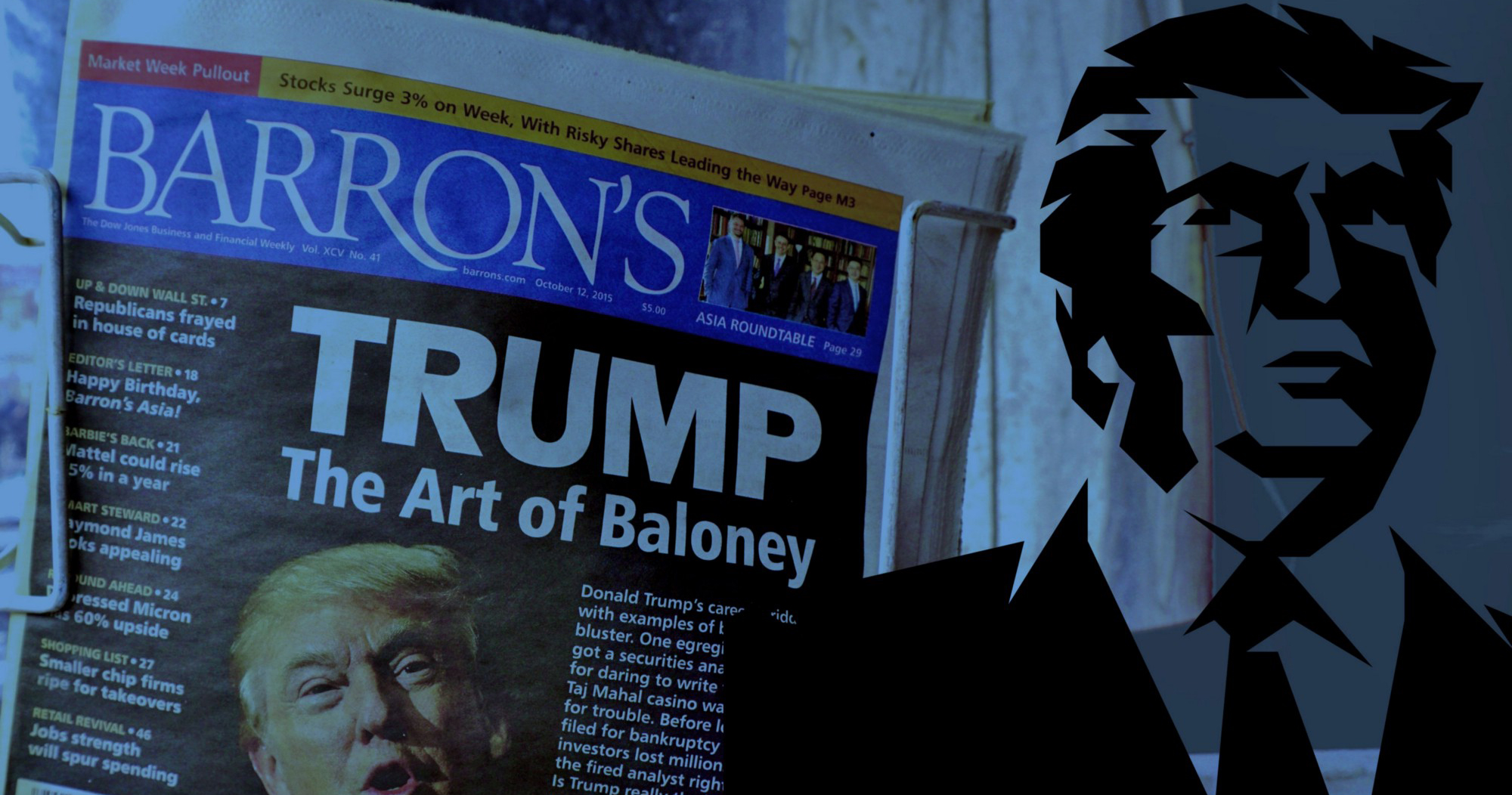
During a February campaign stop in Texas, Trump had news for The New York Times and The Washington Post: If he wins the presidency, the Times and the Post will “have problems.”
“One of the things I’m going to do if I win, and I hope we do and we’re certainly leading. I’m going to open up our libel laws so when they write purposely negative and horrible and false articles, we can sue them and win lots of money,” Trump said in Fort Worth.
“We’re going to open up those libel laws,” he continued. “So when The New York Times writes a hit piece which is a total disgrace or when The Washington Post, which is there for other reasons, writes a hit piece, we can sue them and win money instead of having no chance of winning because they’re totally protected.”
Thankfully, the First Amendment — and freedom of the press in particular — would be safe under a Trump administration. That’s because there are no federal libel laws to “open up.” Legal claims for libel arise under state laws, which a President Trump could do nothing about. The president of the United States only has the power to sign and veto federal law passed by the U.S. Congress.
That said, if Donald Trump does win the White House, he could use his bully pulpit to encourage state legislatures to liberalize state-law restrictions on defamatory speech or persuade members of his party to introduce and pass a federal libel statute. Neither legislative horizon appears even remotely likely, partially because the scope of such laws is still limited by the First Amendment, which protects, among other things, the freedoms of speech and of the press.
The Constitution imposes a high barrier for libel suits brought by public officials, like Mr. Trump, by the very virtue of the power they wield in society. For a public official to win a libel suit, the plaintiff must not only show that the defendant published a false and defamatory statement — but that the defendant did so maliciously.
These robust protections are in place for a very good reason. In a democracy, public discourse is often heated. If the courts were to punish all false statements regardless of motive, observed a majority of the Supreme Court, it could “lead to intolerable self-censorship” by the media.
In other words, a journalist who published erroneous information about a public figure without knowing it was wrong is constitutionally protected. This critical limitation on libel laws, according to an earlier Supreme Court ruling, reflects our “profound national commitment to the principle that debate on public issues should be uninhibited, robust, and wide‐open, and that it may well include vehement, caustic, and sometimes unpleasantly sharp attacks on government and public officials.”
Despite his lack of legal authority to “open up our libel laws,” a President Trump would almost certainly limit the individual rights enshrined in the First Amendment. Regularly on the campaign trail, he has shown contempt not only for free speech but also the freedom of the press and the right to protest.
A month ago, Trump took to Facebook to denounce The Washington Post and make it harder for its reporters to cover his campaign. “Based on the incredibly inaccurate coverage and reporting of the record setting Trump campaign,” he wrote, “we are hereby revoking the press credentials of the phony and dishonest Washington Post.”
The Post now joins The Huffington Post, The Daily Beast, Politico, BuzzFeed News, Mother Jones, Gawker, Univision, and The Des Moines Register on Trump’s media blacklist. Kathleen Culver, associate director of the Center for Journalism Ethics at the University of Wisconsin-Madison, said the billionaire’s actions are making it harder and harder for reporters to do their jobs. “I think the Trump candidacy has challenged journalism more than virtually anything in my memory,” she told the Pittsburgh Post-Gazette.
Beyond revoking press credentials from some of the country’s most prestigious and popular media outlets, members of the media have been mocked and assaulted while covering his campaign. Last year, Trump mimicked the mannerisms of a reporter from The New York Times who has arthrogryposis, a rare disease that affects how a person’s limbs move. In March, Trump’s then-campaign manager grabbed the arm of Michelle Fields — a reporter from the conservative news site Breitbart — and yanked her away from Trump.
None of this should be surprising considering Trump’s open hostility toward the media. “I would never kill them, but I do hate them,” he said. “And some of them are such lying, disgusting people.”
Trump’s rhetoric and aggressive policing of his events also call into question how a Trump administration would respond to nonviolent protest. There have been at least 20 incidents of violence at Trump events since last October, according to the online news magazine Slate. In one of the earliest ones, a Black protester at a Trump rally was pummeled by the candidate’s supporters before being ejected. Trump’s response: “Maybe he should have been roughed up, because it was absolutely disgusting what he was doing.”
Some months later, Trump told a crowd at one of his rallies that he would “like to punch” a protester in the face who was thrown out of the event. When another Black protester was sucker-punched in the face by a Trump supporter, the candidate went so far as to float the idea of paying the man’s legal bills, who Trump said “obviously loves his country.”
While presidential candidates have every right under the First Amendment to control the message at their events and eject disruptive protesters, this behavior does not instill confidence in Trump’s reverence for the freedoms of speech, expression, and assembly. His words and actions on the campaign trail call into question how he would act if confronted with widespread and sustained protests.
The First Amendment is arguably the most important amendment of the Bill of Rights because it protects the means by which a nation governs itself. There is cause for concern that protected First Amendment freedoms would come under assault by a Trump administration, even if its proposed policies don’t stand a chance of surviving a legal challenge.
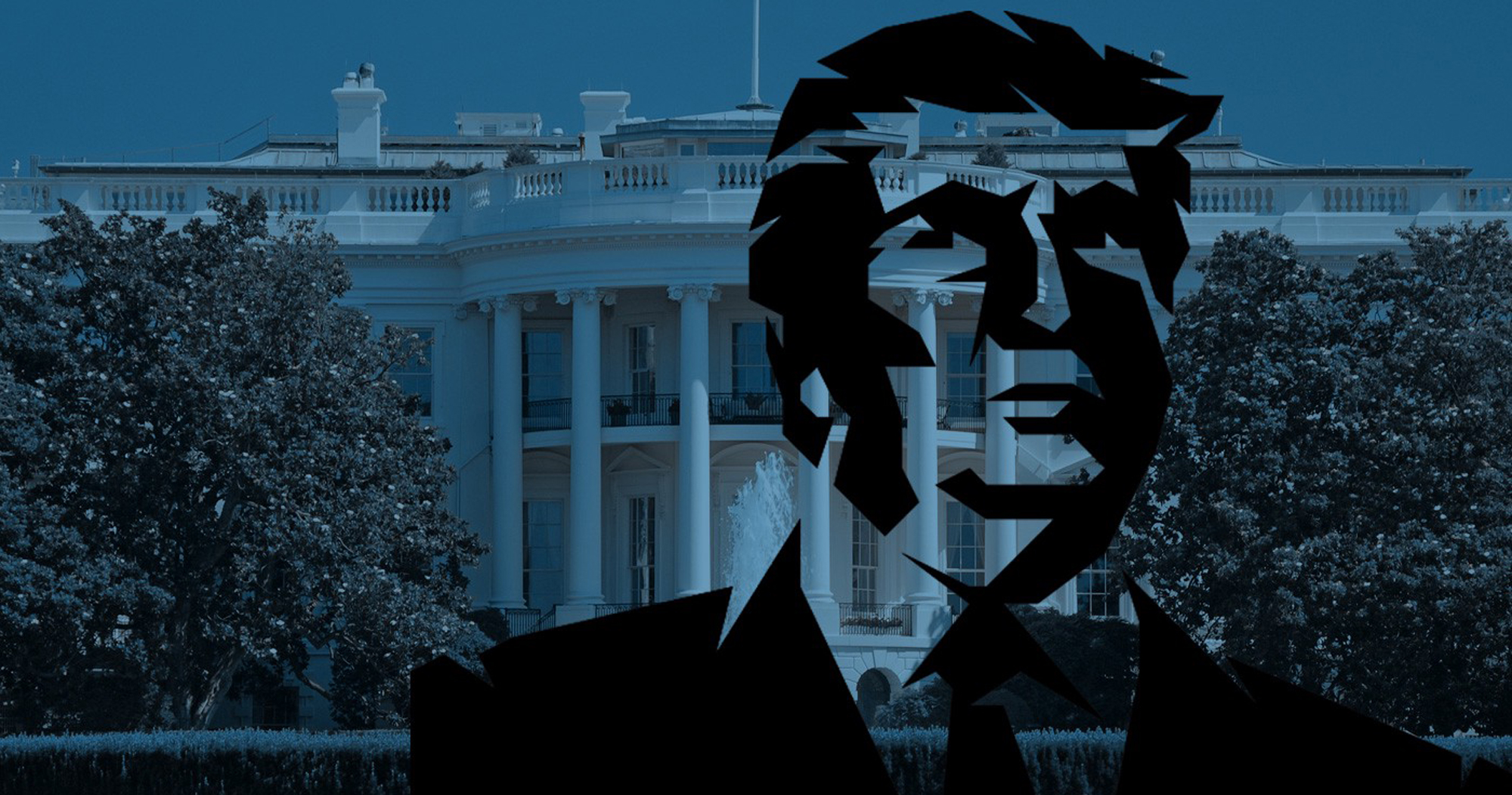
The constitutional government of the United States of America has survived the War of 1812, the Civil War, and the great rights revolutions of the 20th century. It will no doubt survive Donald Trump should he become our 45th president.
But it is important to remember those dark times when the U.S. government — often with public support — conspired against the nation’s most cherished ideals of liberty and equality for all. Among the more unsavory chapters of U.S. history are the Alien and Sedition Acts, Japanese-American imprisonment during World War II, and the long dark night of Jim Crow. Many Americans today rightfully look back at these injustices with horror and shame.
Under a Trump presidency, whole categories of people — Latinos and Hispanics, American Muslims, and reporters and vocal critics of Trump — could potentially be deprived of their constitutional rights because of their immigration status, their religion, their political beliefs, or their livelihoods.This is to say nothing of millions of women who might face prosecution for seeking an abortion if Trump once again changes his mind on this issue.
Our analysis shows that Trump’s policies, if implemented, would lead to a heavy edit of the Constitution. The First, Fourth, Fifth, and Eighth Amendments to the Constitution would no longer protect certain people. The fundamental creed of this nation, that people have natural rights that cannot be violated by government, would be cast aside by its most powerful leader: the president of the United State of America.
There is only so much damage a Trump administration can do, however. Our tradition of protest protects the rights of Americans and immigrants to organize and speak out against Trump, before Election Day and in the event he is elected president. Our system of checks and balances would withstand his contempt for constitutional order.
But should our country ever find itself under the thumb of his proposed policies, make no mistake: We’ll be seeing him in court.

100 Days of Resistance | American Civil Liberties Union
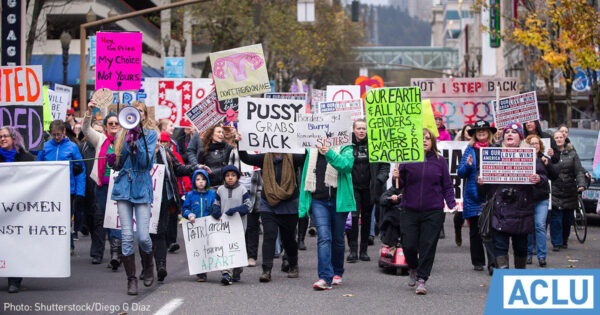
Women's March: A State-By-State Guide | American Civil Liberties Union

The Confirmation Sessions | American Civil Liberties Union

Trump Transition Watch | American Civil Liberties Union
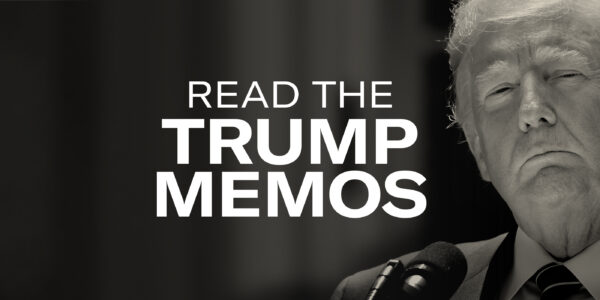
Civil Liberties
+7 Issues
The Trump Memos
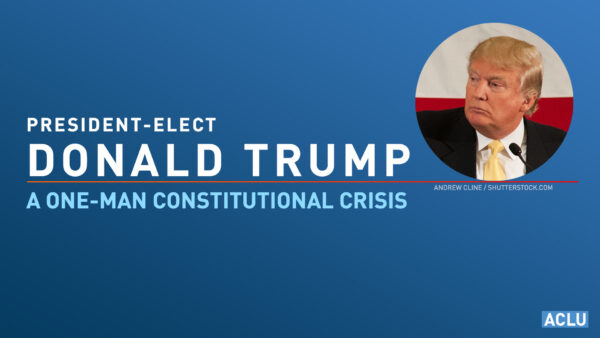
Donald Trump: A One Man Constitutional Crisis | American Civil Liberties Union

Civil Liberties
